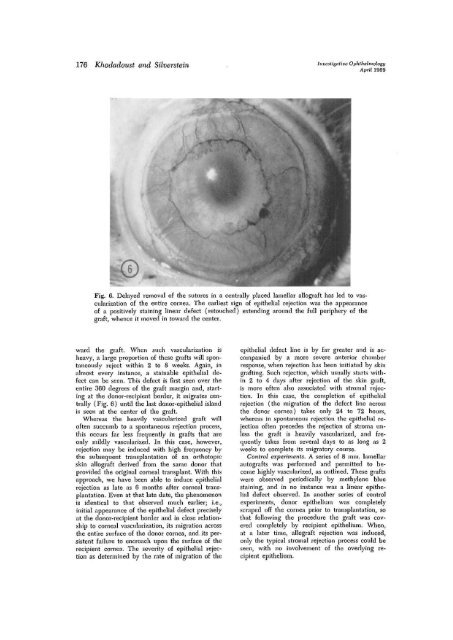The survival and rejection of epithelium in experimental corneal ...
The survival and rejection of epithelium in experimental corneal ...
The survival and rejection of epithelium in experimental corneal ...
Create successful ePaper yourself
Turn your PDF publications into a flip-book with our unique Google optimized e-Paper software.
176 Khodadoust <strong>and</strong> Silverste<strong>in</strong> hwcstigutivo Ophthalmology<br />
April 1969<br />
Fig. G. Delayed removal <strong>of</strong> the sutures <strong>in</strong> a centrally placed lamellar allograft has led to vascularization<br />
<strong>of</strong> the entire cornea. <strong>The</strong> earliest sign <strong>of</strong> epithelial <strong>rejection</strong> was the appearance<br />
<strong>of</strong> a positively sta<strong>in</strong><strong>in</strong>g l<strong>in</strong>ear defect (retouched) extend<strong>in</strong>g around the full periphery <strong>of</strong> the<br />
graft, whence it moved <strong>in</strong> toward the center.<br />
ward the graft. When such vascularization is<br />
heavy, a large proportion <strong>of</strong> these grafts will spontaneously<br />
reject with<strong>in</strong> 2 to 8 weeks. Aga<strong>in</strong>, <strong>in</strong><br />
almost every <strong>in</strong>stance, a sta<strong>in</strong>able epithelial defect<br />
can be seen. This defect is first seen over the<br />
entire 360 degrees <strong>of</strong> the graft marg<strong>in</strong> <strong>and</strong>, start<strong>in</strong>g<br />
at the donor-recipient border, it migrates centrally<br />
(Fig. 6) until the last donor-epithelial isl<strong>and</strong><br />
is seen at the center <strong>of</strong> the graft.<br />
Whereas the heavily vascularized graft will<br />
<strong>of</strong>ten succumb to a spontaneous <strong>rejection</strong> process,<br />
this occurs far less frequently <strong>in</strong> grafts that are<br />
only mildly vascularized. In this case, however,<br />
<strong>rejection</strong> may be <strong>in</strong>duced with high frequency by<br />
the subsequent transplantation <strong>of</strong> an orthotopic<br />
sk<strong>in</strong> allograft derived from the same donor that<br />
provided the orig<strong>in</strong>al <strong>corneal</strong> transplant. With this<br />
approach, we have been able to <strong>in</strong>duce epithelial<br />
<strong>rejection</strong> as late as 6 months after <strong>corneal</strong> transplantation.<br />
Even at that late date, the phenomenon<br />
is identical to that observed much earlier; i.e.,<br />
<strong>in</strong>itial appearance <strong>of</strong> the epithelial defect precisely<br />
at the donor-recipient border <strong>and</strong> <strong>in</strong> close relationship<br />
to <strong>corneal</strong> vascularization, its migration across<br />
the entire surface <strong>of</strong> the donor cornea, <strong>and</strong>. its persistent<br />
failure to encroach upon the surface <strong>of</strong> the<br />
recipient cornea. <strong>The</strong> severity <strong>of</strong> epithelial <strong>rejection</strong><br />
as determ<strong>in</strong>ed by the rate <strong>of</strong> migration <strong>of</strong> the<br />
epithelial defect l<strong>in</strong>e is by far greater <strong>and</strong> is accompanied<br />
by a more severe anterior chamber<br />
response, when <strong>rejection</strong> has been <strong>in</strong>itiated by sk<strong>in</strong><br />
graft<strong>in</strong>g. Such <strong>rejection</strong>, which usually starts with<strong>in</strong><br />
2 to 4 days after <strong>rejection</strong> <strong>of</strong> the sk<strong>in</strong> graft,<br />
is more <strong>of</strong>ten also associated with stromal <strong>rejection</strong>.<br />
In this case, the completion <strong>of</strong> epithelial<br />
<strong>rejection</strong> (the migration <strong>of</strong> the defect l<strong>in</strong>e across<br />
the donor cornea) takes only 24 to 72 hours,<br />
whereas <strong>in</strong> spontaneous <strong>rejection</strong> the epithelial <strong>rejection</strong><br />
<strong>of</strong>ten precedes the <strong>rejection</strong> <strong>of</strong> stroma unless<br />
the graft is heavily vascularized, <strong>and</strong> frequently<br />
takes from several days to as long as 2<br />
weeks to complete its migratory course.<br />
Control experiments. A series <strong>of</strong> 8 mm. lamellar<br />
autografts was performed <strong>and</strong> permitted to become<br />
highly vascularized, as outl<strong>in</strong>ed. <strong>The</strong>se grafts<br />
were observed periodically by methylene blue<br />
sta<strong>in</strong><strong>in</strong>g, <strong>and</strong> <strong>in</strong> no <strong>in</strong>stance was a l<strong>in</strong>ear epithelial<br />
defect observed. In another series <strong>of</strong> control<br />
experiments, donor <strong>epithelium</strong> was completely<br />
scraped <strong>of</strong>f the cornea prior to transplantation, so<br />
that follow<strong>in</strong>g the procedure the graft was covered<br />
completely by recipient <strong>epithelium</strong>. When,<br />
at a later time, allograft <strong>rejection</strong> was <strong>in</strong>duced,<br />
only the typical stromal <strong>rejection</strong> process could be<br />
seen, with no <strong>in</strong>volvement <strong>of</strong> the overly<strong>in</strong>g recipient<br />
<strong>epithelium</strong>.
















